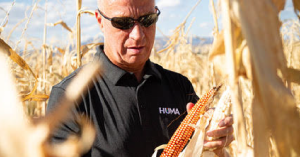In commodity crop production, we talk a lot about bushels per acre. Because that’s how farmers get paid. But what exactly does bushels per acre mean? A bushel is the unit of measure we use in the USA (other parts of the world use tons or metric tons) to calculate yield, verify shipments and set pricing standards for crops such as corn, soybeans, wheat, canola, rice and sorghum. There’s a good chance your grandparents had a bushel basket laying around their house, garage, or barn. If you were to fill that basket to the brim with corn, you’d have one bushel’s worth.
So how did we get to using bushels to establish grain standards? This dates to the Middle Ages. Bushel baskets were popular containers in the British Isles, so they were used to facilitate fair grain trade. Over time, volume measurements were established to further refine the standards. This resulted in various weight assignments per bushel, depending on the grain. For corn, one bushel equals 56 pounds. For soybeans and wheat, it’s 60 pounds. So, if your wheat yields 80 bushels per acre, you’ve produced 4,800 pounds of grain per acre. Another popular measurement is the peck. Four pecks equal one bushel. You’re no doubt familiar with the famous tongue-twister “Peter Piper picked a peck of pickled peppers”. Now you know Peter picked enough peppers to fill one-quarter of that bushel basket you saw at your grandparent’s house.
“We are looking to help drive this movement, not just ride along with it.” That’s how I spoke of Huma’s role in the regen ag/sustainably grown crops movement in the current issue of CropLife. Making good on that statement, I’ll be joining Mitchell Hora of Continuum Ag on his popular TopSoil webinar, October 3 at 1:00 Central time (11:00 am in Arizona). We’ll discuss “Using Humics & New Products to Lower Your CI Score.” Carbon intensity (CI) scores are a game changer for agriculture, and Huma. They offer an opportunity for farmers to create a new revenue stream by utilizing soil health and carbon sequestering practices. This includes utilizing humic solutions to reduce the use of synthetic fertilizers/pesticides and improve soil health. Iowa-based Continuum Ag are leaders in the soil health space, counseling farmers in 42 states and 20 countries. Founder Mitchell Hora made Forbes prestigious 30 leaders under 30 list. We cooperated with research trials on the Hora farm this year. Mitchell and I have been friends for several years, initially meeting through my involvement as a mentor for the AgLaunch ag start-up accelerator program. Please mark your calendars and join us in what promises to be an interesting and entertaining session.
“Back to normal” is how you could describe the current nitrogen fertilizer market. Last week the price for anhydrous ammonia was around $600 per ton. That’s $1,000 below the record-high peak of 2022 and reasonably within the price range we saw from 2013-21. But corn prices are also dropping dramatically – over $3 below 2022 peaks – hitting the lowest levels we’ve seen since 2020.
Unless it’s to defoliate cotton, you don’t normally associate the fall with crop dusters. And certainly not in the Midwest. But many pilots have extended their flight time by applying cover crops. By replacing spray booms with spreaders, yellow airplanes can apply rye, oats, radish and other biomass boosters into existing crops. This helps the covers become established earlier and helps growers manage time during the crunch of harvest. Aerial applicators are now seeding 3.8 million acres of cover crops annually.
Back home in western Illinois, corn yields are coming in around 220-230 bu/A on those fertile Muscatine soils. Much of Illinois experienced very dry and hot growing conditions this season. But as I always say, those rich, dark soils can be very forgiving.
On Thursday I have the privilege of speaking to a large group of high school students about my favorite subject, agriculture. It’s part of Agricenter International’s Agriculture Field Day. There’s nothing more rewarding for me than helping educate and inspire young people toward pursuing a career supporting the world’s greatest profession.
Related Posts

Proof of His Vision: The 1984 Humic Acid Study
Decades before humic acids became more understood in agriculture, Dr. Jordan G. Smith was already testing their impact on plant growth. This newly uncovered 1984 study, co-authored by Huma’s founder, validates a vision that still drives our mission today.

This Week In Ag #100
Farmers grow food. That’s a simple and straight-forward premise. Or is it? We continue to shake our heads at survey results that reveal many consumers think their food comes from the grocery store. But what about the industry itself? If we’re being totally honest, we should ask: are we largely focused on growing food, or producing commodities?

This Week in Ag #50
When explaining the carbon offset market, many of you have heard me give the example of companies and individuals purchasing carbon credits to “offset” their carbon footprints. By nature of what they do, some businesses such as airlines have no choice, as they’ll otherwise never come close to meeting self-imposed carbon footprint targets.


